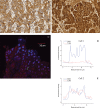Toll-like receptors 1, 2, 4 and 6 in esophageal epithelium, Barrett's esophagus, dysplasia and adenocarcinoma
- PMID: 27008696
- PMCID: PMC5029654
- DOI: 10.18632/oncotarget.8151
Toll-like receptors 1, 2, 4 and 6 in esophageal epithelium, Barrett's esophagus, dysplasia and adenocarcinoma
Abstract
Background: Toll-like receptors (TLRs) recognize microbial and endogenous ligands and have already shown to play a role in esophageal cancer. In this study, we evaluated especially TLRs that sense bacterial cell wall components in Barrett's esophagus, dysplasia and esophageal adenocarcinoma.
Methods: TLRs 1, 2, 4 and 6 were stained immunohistochemically and assessed in esophageal specimens from patients with esophageal dysplasia (n = 30) or adenocarcinoma (n = 99). Structures and lesions were evaluated including normal esophagus (n = 88), gastric (n = 67) or intestinal metaplasia (n = 51) without dysplasia, and low-grade (n = 42) or high-grade dysplasia (n = 37), and esophageal adenocarcinoma (n = 99).
Results: We found TLR1, TLR2, TLR4 and TLR6 expression in all lesions. TLR expression increased in Barrett's mucosa and dysplasia. There was profound increase of TLR expression from gastric- to intestinal-type columnar epithelium. In cancers, high nuclear and cytoplasmic staining of TLR4 associated with metastatic disease and poor prognosis.
Conclusions: TLR1, TLR2, TLR4 and TLR6 are upregulated during malignant changes of esophageal columnar epithelium. Increased TLR4 expression associates with advanced stage and poor prognosis in esophageal adenocarcinoma.
Keywords: Toll-like receptor 1; Toll-like receptor 2; Toll-like receptor 4; Toll-like receptor 6; esophageal adenocarcinoma.
Conflict of interest statement
The authors state no potential conflicts of interest.
Figures



References
MeSH terms
Substances
LinkOut - more resources
Full Text Sources
Other Literature Sources
Medical

